Introduction: The anti principle.
An aesthetics of anti-aesthetics does not imply a negation of
aesthetics. Rather, it is intended to refer to negation itself and an
accompanying aesthetics of negation, or, alternatively, an aesthetics
of opposition, or, alternatively, an aesthetics of the anti.
Bolter and Grusin (2000) have popularized the notion of remediation
as fundamental to the function of digital media, and here the emphasis
is similar. I wish to consider the origin, nature, and pleasures of digital
game representations and the resulting anti-ness of
digital game forms.
Of all those characteristics distinguishing the aesthetic experience of digital media – and, particularly, the experience of digital games – the repetitiveness of that experience is most peculiar. In other, older and (more conventionally) less interactive media, aesthetic pleasures appear both more immediate and more direct. For instance, the enjoyment of the visual, aural, and kinesthetic arts is as much in the moment of their bodily experience as in either their delayed reflection or persistent repetition. And, to some extent, this is true of digital games as well, particularly as regards certain types of games (such as first-person shooters), which employ visual signs appealing directly to the senses and thus invoking mechanical and, often, involuntary responses.
However, regardless of the quality of images employed, the digital interface of computer games allows no direct and immediate access to its patterns and designs. Digital game images are always images in motion, and that motion is always in reference to something else: the non-visual (or, here, the anti-visual). The necessities of the digital game interface delay and subsequently contextualize aesthetic experience within the rules of the game or, put more broadly, within an interactive and self-reflexive play.
Thus, in contrast to other, non-digital aesthetic forms, through continuous repetition and recursion, digital games access and return to a single and particular moment of formal engagement, which is, during that return, contextualized and reengaged as a novelty of false experience, or anti-experience. This peculiar aesthetic experience is then both like and unlike the experience of more traditional aesthetic forms.
I will argue here that the root of an extended, repetitive, and formal engagement with the rules and mechanics of aesthetic form, as demonstrated during digital game play, is the result of a deeply rooted anti principle accentuated by the malleable and discontinuous nature of digital media. And, further, I would claim this principle originates within a natural and largely intractable human semiosis.
To this end, let me briefly introduce a few antecedents to this proposed construct of anti-ness.
Anti-philosophy.
Doubt occupies a central position in many of the more perplexing
problems of human epistemology. Descartes’ famous aphorism, “Cogito,
ergo sum,” remains tautological until replaced by the more reasonable
“Dubito, ergo sum.” For, among all cognitive functions, doubt
is the single function incapable of being doubted and, thus, the single
function that carries the artifice of human thought, like a turtle, on
its back.
If you would be a real seeker after truth, it is necessary that at least once in your life you doubt, as far as possible, all things.
Descartes, Principles of Philosophy
Hegelian dialectics emphasized the critical role of antithesis as a catalyst for subsequent synthesis and historical progression. Later philosophical inquiry disassociated antithetical forms from a strictly rational Hegelian context and examined the implications of those forms within the tangled hierarchies of more socially and psychologically relevant domains. Within phenomenological and existentialist philosophy, for instance, doubt, denial, and resulting conflicts between Self and Other are associated with personal freedoms and independence of will.
A core anti principle might then be found at the base of human despair (Kierkegaard) and as the cause of human enlightenment (Nietzsche). And, a similar principle might be located in the radical skepticism of postmodern aesthetics, marked by, among other things, the nihilist leanings of dadaism, punk rock, and all those deconstructions.
Indeed, the seeming lack of any embedded order or coherence in the vast data constructs of digital media (the World Wide Web, for instance), accompanied by our persistent human desire to drill, Google-like, down to some single datum of individual Self-interest, regardless of its Otherly origin, well represents the inclination of the anti to identify and prioritize the singular, the distinctive, and the selfish.
Spencer-Brown (1972) positioned the fundamental function of all logic (and, in fact, of all cognition) as exactly this: A generic and primitive mark of distinction that must precede any subsequent separation of Self and Other.
At this more primitive level, all acts of distinction and indication are identical; qualitative differences are smoothed out, and focus is reduced to the mere act of creating boundaries separating this from that. All distinctions, indications, and values and thus treated alike.
Merrill 1995, 141
However, while such a broadly conceived anti principle is clearly associated with the negation or the opposition of some Other, this principle is not as often or as willingly associated with a blanket negativity.
Among other things I wished to translate and adapt to my own ends the Heideggerian word Destruktion or Abbau. Each signified in this context an operation bearing on the structure or traditional architecture of the fundamental concepts of ontology or of Western metaphysics. But in French "destruction" too obviously implied an annihilation or a negative reduction much closer perhaps to Nietzschean "demolition" than to the Heideggerian interpretation or to the type of reading that I proposed.
Derrida 1985
Thus, the anti principle I would conjure is willful, primitive, self-serving, and universal in form. It may function destructively or constructively (or, in linguistic terms, with compositionality) in social and psychological domains. More readily distinguished by its form than by its function, the anti is always indicative of human agency. And, therein, the dark and the negative and the antithesis are not simple intermediaries existing prior to some yet-to-evolve, more rational context; rather, the anti principle drives and defines human rationality and all subsequent representational processes (or semiosis) that we use to access, measure, and interpret human experience.
Further, as a recursive function, this anti principle is self-similar and must exist both outside and in opposition to the boundaries of its own determination. That is, the anti function may operate with or without any formal argument other than itself.
These two basic characteristics – self-similarity and formal independence – make the anti principle paradoxical, and, for good or ill, incapable of conventional normative evaluation. Indeed, when looked at from within some normative context (i. e., from within some pre-existing structure yet to be ravaged), the anti appears little more than dysfunctional: random, chaotic, and incorrigible.
Yet so does play appear.
Anti-play.
The anti principle is perhaps best conceptualized as
a form of human play. There is some support for this association.
Huizinga (1955), for instance, assigns importance to opposition, conflict, and the concept of the agon in the continuously contested nature of play and games. This theme of agonistic play is then extended by Turner (1990) and, later, Spariosu (1997), who finds diaspora and the “ludic-liminal” exile of Self necessarily set apart from the logocentric rules and regulations of more rational and rationalized games.
I sometimes talk about the liminal phase being dominantly in the “subjunctive mood” of culture, the mood of maybe, might-be, as-if, hypothesis, fantasy, conjecture, desire, depending on which of the trinity, cognition, affect, and conation (thought, feeling, or intention) is situationally dominant …liminality can perhaps be described as a fructile chaos. A fertile nothingness, a storehouse of possibilities, not by any means a random assemblage but a striving after new forms and structure, a gestation process, a fetation of modes appropriate to anticipating postliminal existence.
Turner 1990, 11-12
…liminality is more than a passive, negative condition or the intermediary-mediating phase between two positive conditions…Liminality contains both positive and active qualities.
Spariosu 1997, 38
The liminal is a particularly resonant anti-concept within play theory’s so-called magic circle. Conventional accounts of a magic circle (see Salen and Zimmerman 2003) emphasize a distinction between play and non-play. However, perhaps more in line with the original use of the term (see Copier 2005), the boundary condition itself – i. e., the circling or the separating function (cf. Nieuwdorp 2005) is more fundamental and telling than any content therein encircled.
It is precisely play as a purely formal activity --serving only to distinguish itself from some Other – that Caillois (2001) described as “pure waste.” Very early play theory (Karl Groos, The Play of Man, 1901) likewise found little reason to account advantageously for the random, chaotic, and destructive functions of play as anti-work. And, current play theory devoted to explaining the educational benefits of play (Gee 2003; Papert 1993) likewise does little to explain, justify, or even acknowledge the purely formal and/or actively negative consequences of an anti-educational play in animals and humans.
Most theories of play, in fact, neatly divide between, on one hand, rational and developmental theories concerned with the normative functions and benefits of so-called good play; and, on the other hand, accounts of a more irrational and agonistic bad play involving Bacchanalia and other Dionysian, seemingly irrational behaviors. It is this latter group of theories that is most likely to consider play as a formal mechanism (Caillois: paidiea) that functions, if at all, to question, doubt, and reconstruct the rules of conventional society.
Perhaps because it is so difficult to reconcile the wanton nature of free play with its supposed educational and adaptive benefits, recent summaries of play theory (Salen and Zimmerman 2005; Raessens and Goldstein 2005) tend more often to compromise than distinguish these separate conceptualizations.
My goal here is to attribute all functions of play – positive and negative – to a single set of formal properties. Thus, I would offer an anti-aesthetic as an aesthetic of form alone. Or, in short, like play, the anti-aesthetic is and is only about itself.
Anti-form.
Poetry is language in its aesthetic function.
Roman Jakobson, Modern Russian Poetry, 1921
At the core of both [early] Russian and American formalism is the notion that literature serves a particular aesthetic function apart from that of everyday or conventional or common language. In Art as Technique, Sjklovsky describes the purpose of art (including “artistic” or poetic language) as reestablishing the “process of perception.” In this function, art “defamiliarizes” those objects to which it refers, creating a sense of strangeness (ostranenie). Ostranenie then re-engages the process of perception, as that process exists prior to its mediation by language. During this re-engagement, literature functions in a manner somewhat akin to phenomenological “bracketing”; literature defamiliarizes language through a self-referential process with consistent and measurable formal properties.
Myers 2004
Early Russian formalism, unburdened by those cultural contexts which were later to prove its demise, offered an inclusive theory of human symbolic experience that bridged linguistics, aesthetics, and (if such a thing had been developed more fully at the time) cognitive science. Russian formalism assumed that natural language intervenes between human perception and human self-awareness through the mechanics of human representationalism or semiosis.
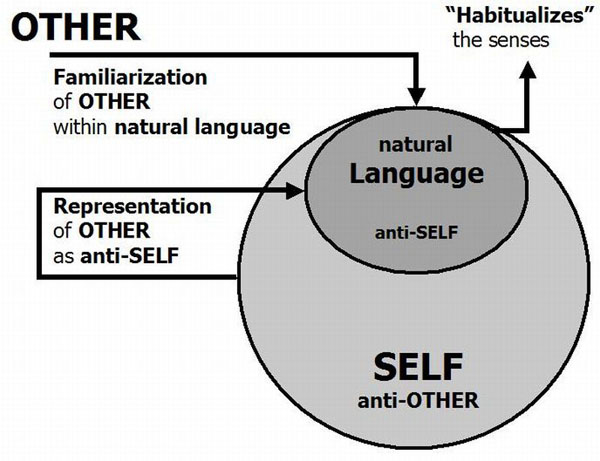
Figure 1. The formalist principle: The function of natural language.
Within this formalist model, the mechanics of natural language are embedded within the representational properties of the mind (cf. Brentano’s intentionality) and, over time, habitualize the senses. During this habitualization process, natural language increasingly mediates and therein transforms and distorts human perception and, as a result of this distortion, human experience. That is, though language ever remains a representational medium, we come to experience and interpret language in a manner that substitutes interpretation and representationalism for those original, raw and primal sensory experiences that preceded natural language and first distinguished Self and Other.
Given this context, poetic language functions to call attention to or re-reference the transformations and distortions of natural and conventional language. This reference cannot be straightforward, however, since poetic language, as a subset of natural language, must necessarily function within the common context (or domain) of representationalism.
Since poetic language cannot transcend the representational system to which it refers, poetic language is necessarily self-referential: Poetic language both calls attention to itself (i. e., is reflexive); and calls attention to the representational process that allows it to call attention to itself (i. e., is recursive). These two qualities --self-reflection and recursion --qualify poetic language as form of anti-language.
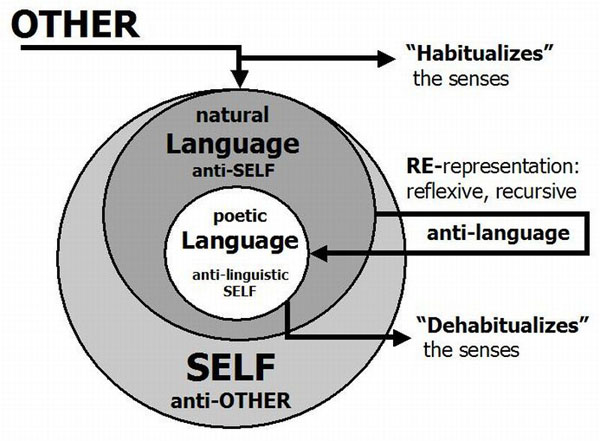
Figure 2. The formalist principle: The function of poetic language.
There are some interesting implications here.
One is that poetic language cannot function without the pre-existing structure of a natural and habitualized language. Another is that the “outcomes” of poetic language (emotion, awe, and the like) are not constructed but revealed. That is, the anti-linguistic Self in Figure 2 refers to a primal and experiential Self, which existed prior to the mediation of natural language and, in fact, still exists beneath the veneer of that language. If so, then aesthetics becomes rightfully the study of the manner in which human experiences are clouded and guised --and, subsequently, evoked and recalled --by the formal properties of representationalism.
There is something quite humanistic in this claim: That all humans possess, within their most basic perceptual mechanisms, the awe, the wonder, and the enlightenment associated with the most engaging forms of art. The function of art is then to unravel mysteries of the mind and body, which are already, in the most basic sense, possessed.
The argument I am offering here is, in parallel to that of early formalism, a rather simple one. I would assert that digital games and interactive play occupy the same position relative to a natural human semiosis that, for the Russian formalists, literature and poetic language occupy relative to a natural human language. Just as literariness is derivative of and functions in opposition to the habituations of natural language, the interactivity of digital media can be understood as derivative of and functioning in opposition to the representations of natural semiosis.
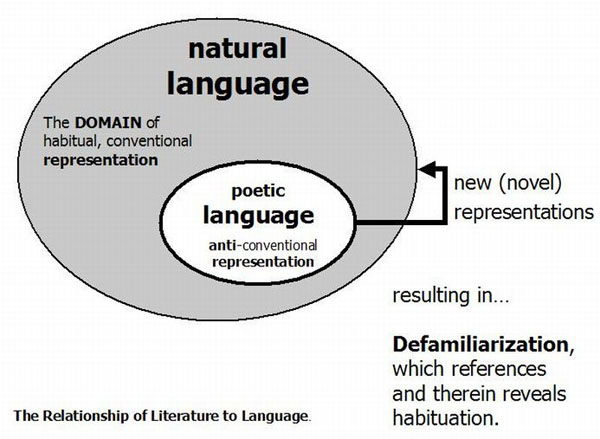
Figure 3a. The relationship of poetic language to natural language.
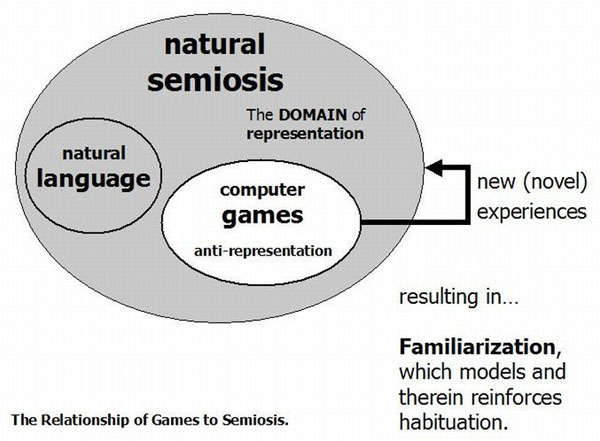
Figure 3b. The relationship of digital games to natural semiosis.
Further, in both cases, it is most useful to think of the function of literary form and digital game form as founded on a common anti (or agonistic play) principle which repeats, recants, and therein reveals the otherwise hidden properties and mechanisms of representationalism.
Of course, language, representationalism, and semiosis overlap, creating some complications.
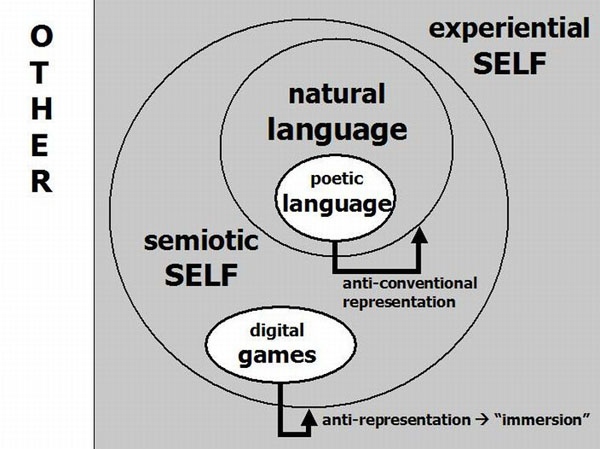
Figure 4. The relationship of poetic language to digital games.
The function of poetic language is in reference to the habitualized conventions of natural language, while the function of digital games is in reference to the natural representation of Self (or semiotic Self). In both cases, the reference refers to and expands the domain of its referent. Poetic language expands the domain of natural language to include the broader (supra-linguistic) representational process. And digital games expand the domain of natural semiosis to include the supra-representational components of direct and immediate experience. These components evoke an anti- experience that we recognize in digital play as “immersion.”
Thus, in parallel with the earlier Jakobson quote – “Poetry is language in its aesthetic function” --we might say that the digital game is semiosis in its (anti-)aesthetic function.
Anti-experience.
Digital games depend upon a set of core mechanics similar to
those of human perception. These mechanics are habitualized, unconscious
(that is, beneath surface awareness), and, like the fundamental characteristics
of both language and perception, required prior to any subsequent aesthetic
experience. Unlike the mechanics of language and perception, however,
these mechanics are not embedded in the human body; they are embedded
in the game interface.
Just as poetic language requires reference to a pre-existing language, the digital game requires reference to a pre-existing set of rules and mechanics. The critical difference, however, is that game play actively constructs those rules and mechanics. Thus, digital games do not reference some physical or biological imperative of natural history; rather, digital games reference the interactive process of constructing human experience and, paradoxically, during this referencing process, digital games reference themselves.
Schema of experience. The digital game interface consists of both game rules (software) and game hardware, which can itself be considered an embedded rules system. It is then useful to consider the interface of digital games as analogous to the “interface” of the human body through which we gather, represent, and interpret our surroundings.
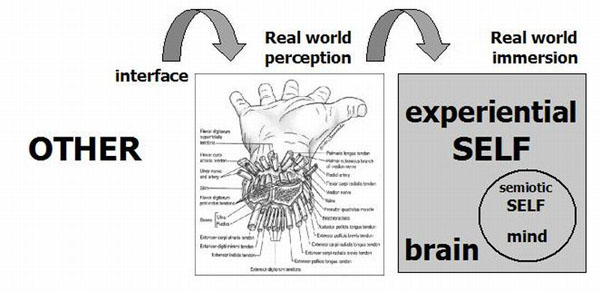
Figure 5a. The physical interface.
Digital games originate within a specific anti-representational portion of the semiotic Self, and, during interactive play, reproduce the semiotic process distinguishing Self and Other. This is necessarily a self-reflexive and recursive semiotic process.
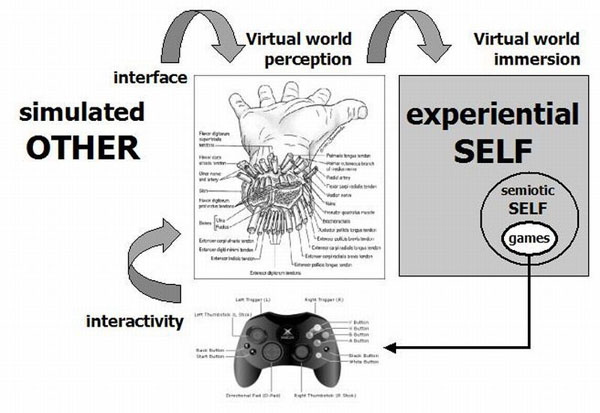
Figure 5b. The psychophysical interface.
Utilizing and referencing this process, the game interface – hardware and software, i. e., the game rules --intervenes and mediates between the (real-world) Other and the domain of experience within which Other and Self are distinguished. In this way, digital games function simultaneously as experience simulators and as the experience being simulated. Game rules overlay and, upon occasion, substitute for the embedded mechanics of sensation.
Interactive games cannot entirely reconstitute the body, but they can and do reconfigure our interpretation of experience in order to prioritize – and de-prioritize – various aspects of that experience. During this process, the domain of real-world experience becomes a (relatively narrower) domain of so-called virtual-world experience. This virtual-world experience then reflects the real world only indirectly though the semiotic process of its own construction --that is, only through its formal properties. Meanwhile, real-world content and the function of that content to test and validate constructions of the Self are lost.
Applied within the semiotic Self, an anti-conventional language (e. g., poetic language) references and evokes the sensation of experience; applied within the experiential Self, an anti-conventional experience can neither reference nor evoke any broader domain. Experience is, put plainly, all we have. Therefore, the anti-principle can only turn upon itself and reproduce formal facsimiles of real-world experiences – anti-icons and anti-experiences – governed, selected, and enjoyed by a corresponding anti-aesthetic.
Anti-aesthetic.
The anti-aesthetic is an aesthetic of the psychophysical
and, as such, borrows assumptions and claims from evolutionary psychology.
For instance, the aesthetic of the anti would claim that the
pleasures of sensation and semiosis are biologically determined and, for
that reason, inextricably linked. These mechanics of sensation and semiosis,
no doubt, have evolved to further the survival of the human organism,
yet these mechanics, for all their value, show gaps and flaws.
Piattelli-Palmarini (1994), for instance, has documented the degree to which human perception and judgment are consistently inaccurate in evaluating real-world events. Our perception – again, including perception and semiosis as linked activities – invites a particular interpretation of the world due to its evolutionary design within a particular natural history. Real-world objects and events outside the physical and conceptual domain of our species remain alien to our senses and, correspondingly, alien to our minds. These invisible and mysterious domains may be as mundane as those portions of the electromagnetic spectrum beyond our natural vision or as exotic as quantum-level physics. We access such domains, if at all, through some anti-intuitional means --e. g., through some mechanical device substituting for natural perception (a radio telescope, for instance) --or, alternatively, through the formal abstractions of mathematics or some other, similarly non-linguistic representational form. Thus, we might understand the form of alien domains through their analogous representation within our own, but the experience of these Otherly domains remains apart from us, despite any ability we might posses to measure, manipulate, or otherwise control their presence and effects.
The psychophysical differs from the physical to the extent that it is a limited - and, because of its limitations, a distorted --subset of the physical. And those formal processes – sensation and semiosis --that construct the psychophysical laws governing our interpretive experiences are those same processes guiding interactive digital game play. Thus, digital game design is locked inside a particular and specific form of human experience, just as poetic language is locked inside a particular and specific form of natural language.
Similar but anti. The anti-aesthetic posits a formal and cognitive aesthetic, which, strictly speaking, reveals rather than constructs emotional response. This aesthetic is located in the interpretation and manipulation of symbolic form rather than in the assignation of any particular content, value, or meaning to that form. It is useful then to distinguish this position from others similar, which may recognize the same fundamental components of digital media play – i. e., repetition --yet assign quite different (non-anti) functions to them.
Example 1. Grodal (2000; 2003), for instance, has drawn a detailed comparison of the aesthetics of film and video games similar to that offered here.
…video games provide an aesthetic of repetition, similar to that of everyday life….The video game experience is very much similar to …an everyday experience of learning and controlling by repetitive rehearsal….the end result of the learning process is what the Russian Formalists called automation, and what psychologists might call desensitization by habituation. [italics in original]
Grodal 2003, 148
Grodal’s position, worth considering further, then goes something like this: The play of digital games is arousing. This arousal is cognitively labeled as specific emotional content according to the feedback players get from the game. And players are, to some important degree, in control of the feedback they get from the game.
Therefore, Grodal claims that digital games as aesthetic experiences reproduce embedded, prelinguistic arousal patterns (including some narratives – or “metanarratives” – importantly among these) and that, during play, players undergo “curiosity, surprise, suspense, and explorative coping” in response to these patterns. Repetitive play enables mastery of the game, but, more significantly, repetitive play allows players to learn and achieve emotional control. Thus, Grodal values the repetition of play primarily as a learning process accomplishing a specific function: emotional self-control.
This position is distinct from an anti-aesthetic insofar as it emphasizes the functional mastery of an emotional state. According to the model presented here, digital games and play evoke a distancing function (an anti-experiential function), which “controls” emotions only insofar as it separates emotions (and all other things) from their common referents within conventional human experience.
The distinction of the anti-aesthetic is that, through self-reference and recursion, a formal process recreates the form of real-world experience within the domain of Self. If and when emotions (i. e., “content”) become involved in this process, these emotions may be just as “real” as those accorded real-world experiences, yet the referents of those emotions will necessarily be something other than their intended (by evolution and the natural history of the species) real-world referents.
For this reason, the digital game experience is both experience in the raw and, simultaneously, the active reinforcement of false experience. Grodal seems to acknowledge the first portion of this claim, but finds little reason to acknowledge or (perhaps) to assign any special relevance to the latter. In this, Grodal’s position is similar to that of much current digital game theory, which locates and analyzes the message or meaning or theme of digital games in the same manner and according to the same aesthetic that those concepts are located and analyzed in film and other, non-digital media.
Example 2. Aarseth (1999) has, in his analysis of the play of the first-person shooter Doom, identified two major tropes as “prenarrative master-figures of experience” (1999, 39): aporia and epiphany. These arise from, respectively, an awareness of some obstacle or problem within the digital game and, subsequently, the revelation of its solution. Aarseth further locates these tropes within digital media in general or, in his terms, within “hypertext discourse” wherein aporia and epiphany together constitute a “fundamental layer of human experience” (1997, 91-2).
If we assign aporia the function of semiotic opposition, and if we assign epiphany the function of semiotic contextualization, then aporia and epiphany are closely analogous to similar concepts within the proffered anti-aesthetic. Yet, while Aarseth carefully distinguishes the aporia of hypertext from that associated with other, “anamorphic” forms, he also clearly couches his aporia-epiphany pair within a literary context.
…we then derive three categories: novels (in which we include Afternoon-type hyperfictions), anamorphic literature (solving enigmas), and metamorphic literature (the texts of change and unpredictability). The tigers that can be observed in the latter are unplanned, unbound, and untamed. But strangely, in these [latter] labyrinths, our influence as literary agents is much more real than in the two previous ones.
Aarseth 1997, 181-2
According to the anti-aesthetic, of course, this latter claim simply cannot be true, since our influence as literary agents must depend upon our natural language proclivities, and these proclivities are trumped, subsumed, and made inconsequential by the anti- experiential interface of repetitive and recursive digital game play.
By associating the mechanisms of aesthetic response with the mechanisms of language and literature (rather than with the mechanisms of semiosis and experience), digital game aesthetics becomes a variant of media determinism in which the formal mechanisms of digital media (e. g., “hypertext discourse”) substitute for those of natural language.
In contrast, an anti-aesthetic claims that the mechanisms of aesthetic response are evoked through self-referral within the mechanisms of digital media, which, in this function, succeed and transcend the more conventional domain of natural and poetic language. Thus, aporia and epiphany are not constructed during digital game design but revealed during digital game play – and can only be masked and distorted during any subsequent analysis of digital games as language-based aesthetic forms.
Anti-conclusions.
An anti-aesthetic is similar to conventional digital game aesthetics
in its emphasis of the repetitive (and even, upon occasion, literary)
references of digital game content. However, an anti-aesthetic
differs from conventional aesthetics in its emphasis of formal (i. e.,
without content) recursion and the bounded, psychophysical domain of digital
game play. The digital game play experience transcends poetic language
and literature in its reference to semiotic mechanisms associated with
(and most likely derivative of) supra- representational interpretive processes.
The most fundamental of these semiotic processes are those distinguishing
Self and Other.
Perhaps the greatest advantage of an anti-aesthetic in this regard is that it readily includes and explains those experiences associated with digital game play that are risky, harmful, against the rules, or, in some other way, bad. Indeed, within the anti-aesthetic, “bad” digital game play is exemplary digital game play.
This exemplary yet bad play includes all emotions and efforts expended prior to Grodal’s sense of mastery and/or prior to Aarseth’s state of epiphany: frustration, isolation, obsession, self-immersion, defeat. These common, universal, and agonistic elements of digital game play embody a false Other constructed, maintained, enjoyed, and ultimately and repetitively destroyed during the active reinforcement of false experience.
Poetic language, as Russian formalist Sjklovsky famously observed, serves "to recover the sense of life, in order to feel objects, to make the stone stony" (Art as technique/design, 1917). But, of course, no figurative stone, however poetically realized, has ever broken any literal bone.
In fact, poetic language can only serve to reveal the representations – the mental constructions --of natural language that, over time, hide and distort the feral sensation of stoniness. And, similarly, digital play, over time, reveals the representations – the mental constructions – of interactive experience.
But to what does those latter representations refer? The poetically realized stone reveals a stoniness of embodied experience. But digital play can reveal only those self- similar mechanisms guiding the repetitive construction of its own experience: play. This play experience is necessarily false due to the absence of any embodied referent --and necessarily real for the same reason. For, as an interpretive mechanism, embodiment most fundamentally distinguishes Self and Other. And it is this distinction alone, isolated within the domain of Self, without regard to any Other, that during play evokes and sustains the hollowed pleasures of the anti-aesthetic.
BIBLIOGRAPHY.
Aarseth, Espen. 1999. “Aporia and Epiphany in Doom and The Speaking Clock: The Temporality of Ergodic Art.” In Cyberspace Textuality: Computer Technology and Literary Theory, edited by Marie-Laure Ryan, 31-41. Bloomington, IN: Indiana University Press.
Aarseth, Espen. 1997. Cybertext: Perspectives on Ergodic Literature. Baltimore: John Hopkins.
Anderson, Joseph D. 1996. The Reality of Illusion: An Ecological Approach to Cognitive Film Theory. Carbondale, IL: Southern Illinois University Press.
Bolter, J. David and Richard A. Grusin. 2000. Remediation: Understanding New Media. Cambridge Massachusetts: MIT Press.
Caillois, Roger. 2001. Man, Play and Games. Translated by Meyer Barash. Urbana, IL: University of Illinois Press.
Copier, Marinka. 2005. “Connecting Worlds. Fantasy Role-Playing Games, Ritual Acts and the Magic Circle.” In Changing Views: Worlds in Play, Digital Games Research Association Conference Proceedings. Vancouver, British Columbia: DiGRA, CD-ROM.
Derrida, Jacques. 1985. “Letter to a friend.” In Derrida and Différance, edited by David Wood and Robert Bernasconi, 1-5. Warwick: Parousia Press. <http:// literature.sdsu.edu / library / derridaletter.html> (1 August 2005)
Erlich, Victor. 1981. Russian Formalism (3rd ed.). New Haven: Yale University Press.
Gee, James P. 2003. What Video Games Have To Teach Us About Learning and Literacy. New York: Palgrave Macmillan.
Grodal, Torben. 2003. “Stories for Eye, Ear, and Muscles: Video Games, Media, and Embodied Experiences.” In The Video Game Theory Reader, edited by Mark Wolff and Bernard Perron, 129-156. New York: Routledge.
Grodal, Torben. 2000. “Video Games and the Pleasures of Control.” In Media Entertainment, edited by Dolf Zillmann and Peter Vorderer, 197-214. Mahwah, NJ: Erlbaum.
Huizinga, Johan. 1955. Homo Ludens: A Study of the Play-Element in Culture. Boston: Beacon Press.
King, Geoff and Tanya Krzywinska, eds. 2002. ScreenPlay: Cinema / Videogames / Interfaces. London: Wallflower Press.
Manovich, Lev. 2001. The Language of New Media. Cambridge, MA: MIT Press.
Merrill, Floyd. 1995. Semiosis in the Post-Modern Age. West Lafayette, IN: Purdue University Press.
Myers, David. 2004. “The anti-Poetic: Interactivity, Immersion, and Other Semiotic Functions of Digital Play.” In COSIGN 2004 Conference Proceedings, edited by Andy Clarke. Split, Croatia: Art Academy, University of Split. < http:// www.cosignconference.org / cosign2004 / papers / Myers.pdf> (1 August 2005)
Nieuwdorp, Eva. 2005. “The Pervasive Interface; Tracing the Magic Circle.” In Changing Views: Worlds in Play, Digital Games Research Association Conference Proceedings. Vancouver, British Columbia: DiGRA, CD-ROM.
Papert, Simon. 1993. Mindstorms: Children, Computers, and Powerful Ideas (2nd ed.). New York: Basic Books.
Perron, Bernard. 2005. “A Cognitive Psychological Approach to Gameplay Emotions.” In Changing Views: Worlds in Play, Digital Games Research Association Conference Proceedings. Vancouver, British Columbia: DiGRA, CD-ROM.
Piattelli-Palmarini, Massimo. 1994. Inevitable Illusions: How the Mistakes of Reason Rule Our Minds. Somerset, NJ: John Wiley & Sons.
Raessens, Joost and Jeffrey Goldstein, eds. 2005. Handbook of Computer Game Studies. Cambridge, MA: MIT Press.
Rascaroli, Laura. 2002. “Like a Dream: A Critical History of the Oneiric Metaphor in Film Theory.” KINEMA. <http:// www.kinema.uwaterloo.ca / rasc022.htm> (1 August 2005)
Salen, Katie and Eric Zimmerman. 2003. Rules of play: Game design fundamentals. Cambridge, MA: MIT Press.
Spariosu, Mihai I. 1997. The Wreath of Wild Olive: Play, Liminality, and the Study of Literature. Albany, NY: SUNY Press.
Spencer-Brown, George. 1972. Laws of Form. New York: The Julian Press.
Tan, Edward S. 1996. Emotion and the Structure of Narrative Film: Film as an Emotion Machine. Translated by Barbara Fasting. Mahwah, N.J.: Lawrence Erlbaum Associates.
Turner, Victor. 1990. “Are There Universals of Performance in Myth, Ritual and Drama?” In By Means of Performance: Intercultural Studies of Theatre and Ritual, edited by Richard Schechner and Willa Appel, 8-18. Cambridge: Cambridge University Press.